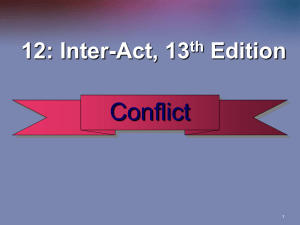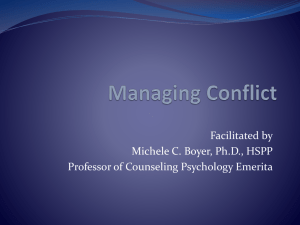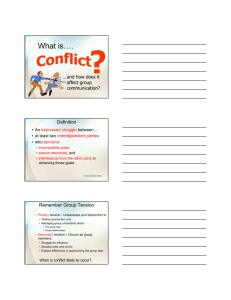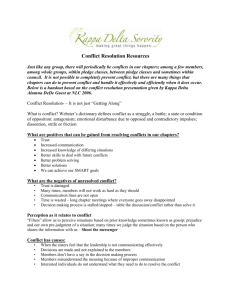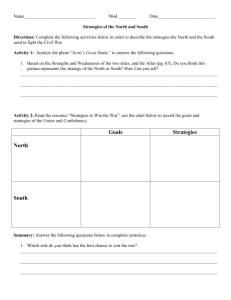Life is like photography
advertisement
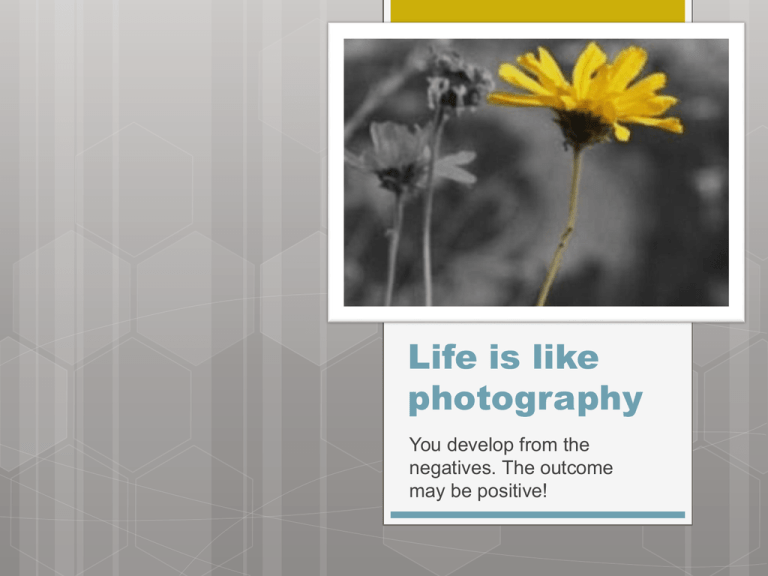
Life is like photography You develop from the negatives. The outcome may be positive! 2 Module 1: Exploring Conflict We think of conflict as negative, however, focusing on conflict resolution can bring about positive results. 3 What is Conflict? 1. to come into collision or disagreement; be contradictory, at variance, or in opposition; clash: The account of one eyewitness conflicted with that of the other. My class conflicts with my going to the concert. 2. to fight or contend; do battle. 3. a fight, battle, or struggle, especially a prolonged struggle; strife. 4. controversy; quarrel: conflicts between parties. 5. discord of action, feeling, or effect; antagonism or opposition, as of interests or principles: a conflict of ideas. 6. a striking together; collision. 7. incompatibility or interference, as of one idea, desire, event, or activity with another: a conflict in the schedule. 4 Who do we have conflicts with? 5 Is there a cost involved with conflict? Avoidance Negotiation Third-party mediation Legal Action Robbery Physical threat Fighting between individuals Fighting between groups Terrorist activity War 6 Conflict Video! 7 Does everyone win? – Win Lose – Lose Win – Lose Lose – Win Win 8 Are there benefits from the outcome of a conflict? 9 Personal Conflicts Think back over the last two weeks. What conflict situations did you encounter? Page 5 in your book provides space for you to reflect on this activity. 10 Personal Conflicts Determine you satisfaction score 5 = Very happy with outcome 4 = Moderately happy 3 = Indifferent; in the middle 2 = Moderately unhappy 1 = Very unhappy with outcome 11 Conflict Outcomes Matrix Their satisfaction = 5 Yours = 1 Their Satisfaction Score 5 Win-lose tradeoffs fall on this line 1 1 5 Your Satisfaction Score Your satisfaction = 5 Theirs = 1 12 What is Conflict Resolution? The process of ending a disagreement between two or more people in a constructive fashion for all parties involved. The methods and process of negotiation, which promote the peaceful ending of social conflict and war. Creative solutions to problems to help organizations move ahead and achieve their goals. Think of conflicts as opportunities to help your organization overcome limitations to growth and change. 13 Understanding the Conflict Resolution Process Acknowledge the conflict Determine the best style of handling the conflict Use the best style for addressing the issue Raise your Conflict IQ Develop skills for Competition and Collaboration 14 What is attitude? A settled way of thinking or feeling, typically reflected in a person's behavior. A position of the body proper to or implying an action or mental state: "the boy was standing in an attitude of despair". 15 What is attitude? 16 Let hear some comments on attitude . . . Zig Ziglar on Attitude 17 Did attitude affect these famous people? 1. …a famous person who was defeated seven times while running for political office? Abraham Lincoln was defeated in eight different elections. Yet he persisted and succeeded in becoming the 16th, and one of the most respected, presidents of the United States. 2. …a cartoonist who was told by the editor of the Kansas City newspaper, “It’s easy to see from these sketches that you have no talent.” Walt Disney was told he had no talent and fired from a newspaper job. He wound up doing volunteer work for a church in an old run down garage. One day he decided to sketch one of the many mice that were running through the garage. This mouse became the famous “Mickey Mouse.” 18 Did attitude affect these famous people? 3. …an author whose first children’s book was rejected by 23 different publishers? Twenty-three different publishers rejected Dr. Seuss’s first book, while the 24th accepted and sold 6 million copies of it. 4. …a famous singer who was fired after his first performance at the Grand Ole Opry? Elvis Presley was fired after his first performance at the Grand Ole Opry. The manager told him, “You ain’t going nowhere, son. You ought to go back to driving a truck.” He went on to become one of the most famous American singers of the 20th century. 19 Did attitude affect these famous people? 5. …a famous actress who dropped out of high school and held a variety of odd jobs, including doing the hair and make-up for corpses, before finally succeeding in show business? Whoopi Goldberg dropped out of high school, was on welfare and worked as a bricklayer, bank teller, and licensed cosmetician. After graduating from Beauty College, she took a job at a mortuary fixing the hair of and applying make-up to the corpses. 6. …a famous author who lived on welfare for years in an apartment infested with mice? J.K. Rowling, author of the Harry Potter series, lived on welfare for years, in an apartment infested with mice, and was rejected by 12 publishers before going on to fame and fortune. 20 Did attitude affect these famous people? 7. …a famous athlete who was cut from the varsity basketball team his sophomore year in high school? Michael Jordan was the athlete who was cut from the varsity basketball team in his sophomore year of high school. Angry and embarrassed, he began to get up early each morning to practice with the junior varsity coach. Eventually he not only made the varsity team, but also became one of the most popular athletes in the world. Michael Jordan is quoted as saying, “I have missed more than 9,000 shots in my career. I have lost almost 300 games. On 26 occasions I have been entrusted to take the game winning shot, and I missed. I have failed over and over and over again in my life. And that is why I succeed.” 21 8. …an inventor who was thrown out of school in the early grades because his teachers thought he couldn’t learn? Thomas Edison was the inventor who was kicked out of school. Following this, he was homeschooled by his mother. It took him over 700 tries before he got the filament right for the light bulb. Edison is quoted as saying: “I have not failed seven hundred times. I have not failed once. I have succeeded in proving that those seven hundred ways will not work. When I have eliminated the ways that will not work, I will find the way that will work.” 9. …a famous Harvard University drop out? Mark Zuckerberg dropped out of Harvard University. He went onto become the youngest millionaire (at the age of 26) and is the CEO of Facebook. 10. …an inventor of a fried chicken recipe that was rejected by more than 1000 restaurant owners? Harland David Sanders (better known as Colonel Sanders) had his fried chicken recipe rejected by more than 1,000 restaurant owners before it was accepted by one. Today, people still eat it at KFCs across the world. 22 Conflict: How do you see it? Consider a few questions from the How do you see it handout. Take about 10 – 15 minutes to answer questions, giving thought to how you would typically react. We will discuss your answers and see how they compare to others in the class. 23 Put a Positive Spin on Conflict! How does the definition of conflict affect the way we think about conflict? What are some negative consequences of conflict? What are some positive outcomes of conflict? List four potential positive outcomes of conflict in an organization. 24 Recap to Module 1 1. A conflict situation is any situation in which two or Parties have differing ______ interests and the ability more ______ to _______ each other’s pursuit of those interests. affect 2. conflict as a Within organizations, there is often ______ result of the need for change. 3. you Your win-lose score is a measure of how well __ interests competed in pursuit of your own _______. 4. Both parties A win-win score is a measure of how well ________ Their interests . collaborated to find and pursue ______ 25 Recap to Module 1 5. A win-win score is defined as the _______ Average of both parties’ scores. 6. On the Conflict Outcomes Matrix, the competitive Success Zone is reached when ______ satisfaction is your high, and _______ satisfaction is low. their 7. On the Conflict Outcomes Matrix, the Joint Success Zone your satisfaction and is only reached when both ______ ______ their satisfaction is ______. high 8. In everyday experience, parties to conflict situations ________ achieve joint success because they do not (b) rarely approach conflict with sufficient skill and care. (a) often (b) rarely 26 Page 33 in leader book Module 2: Understanding your style of response to conflict Avoid Accommodate Compromise Compete Collaborate 27 Avoiding (I Lose, You Lose) Side-stepping or withdrawing from the conflict situation. When you prevent/postpone conflict, it remains unresolved and neither party wins. 28 Accommodating (I Lose, You Win) Putting aside your needs and desires and acquiescing to the other person’s requests/ demands. When a high value is placed on your relationship with the other party. When outcome is of low importance to you, but is of high importance to the other party. T2 29 Compromising (We Both Win, We Both Lose) Resolving the conflict quickly and efficiently by seeking a fair and equitable split between the two positions. Each side concedes on some of their issues in order to win others. Both parties must be flexible and willing to settle for a satisfactory resolution of their major issue. 30 Competing (I Win, You Lose) Seeking to win your position at the expense of the other party losing theirs. Appropriate when only one party can achieve their desired outcome. Best used when outcome is extremely important and relationship is of low importance. 31 Collaborating (I Win, You Win) Cooperating with the other party to try to resolve a common problem to a mutually satisfying outcome. When you join with the other party to compete against the situation, instead of each other. Each side must feel that the outcomes gained through collaboration are better than they could achieve on their own. 32 Thinking about Resolution Watch this student created video demonstrating the five styles of conflict response. 33 How do you respond to conflict? 34 Thinking about Resolution Activity: Brainstorm words that will represent steps from conflict to resolution. Write your words on the board 35 Assess Your Personal Style Use the forms provided to discover more about your personal conflict response style 36 Discuss Personal Styles Do you think that other people will agree with your profile results? What style do you think the people you work with will say you are using most often? 37 Discuss Personal Styles If it is different from your results on the assessment, why do you think this is? 38 Discuss Personal Styles How varied is your approach to conflict? Do you switch easily from style to style? 39 Discuss Personal Styles Do you sometimes use more than one style in sequence? Why? Can you think of a good example of when that is appropriate? 40 Discuss Personal Styles What happens when you are in conflict with someone whose style is very different from yours? Does this create stress or difficulty for you? 41 Sum it all up We will see a video demonstrating each of the five styles of conflict response in action. 42 Module 3: Which Style Should You Use? Avoid Accommodate Compromise Compete Collaborate 43 Diagnosing the Situation The answers depend on many factors but there are two questions that may be helpful here: How important is my relationship with the other party? How important is the outcome to me? 44 Case Study Imagine you are leading a team that is responsible for completing a project and producing a report by the end of next month. One of the team members has not drafted his part of the report, saying he is too busy with his other work and doesn’t have the time. In the last team meeting, you gave him until today’s meeting to catch up. But he didn’t even come to the meeting. When you called him afterward. He questioned your authority and said he had too many problems with his other work to worry about your report right now. Yet you know that the report is important for the entire organization, not just his department, and you can’t imagine what work he might have that could take precedence. You are tempted to “pull rank” as the team leader and threaten him with a poor performance review unless he cooperates. Even though he’s in another department, you know a bad review from his team leader could cause him problems later on. What will you as the team leader do next? 45 How to determine the best style 46 Conflict Handling Styles Collaborate I Win, You Win Importance of relationship HIGH Accommodate I Lose, You Win MEDIUM LOW Compromise We Both Win, We Both Lose Avoid I Lose, You Lose LOW Compete I Win, You Lose MEDIUM Importance of outcome HIGH 47 Accommodating (I Lose, You Win) Putting aside your needs and desires and agreeing to the other person’s requests or demands. Appropriate when a high value is placed on your relationship with the other party. Appropriate when outcome is of low importance to you, but is of high importance to the other party. T2 48 Avoiding (I Lose, You Lose) Side-stepping or withdrawing from the conflict situation. When you prevent/postpone conflict, it remains unresolved and neither party wins. 49 Compromising (We Both Win, We Both Lose) Resolving the conflict quickly and efficiently by seeking a fair and equitable split between the two positions. Each side concedes on some of their issues in order to win others. Both parties must be flexible and willing to settle for a satisfactory resolution of their major issue. 50 Competing (I Win, You Lose) Seeking to win your position at the expense of the other party losing theirs. Appropriate when only one party can achieve their desired outcome. Best used when outcome is extremely important and relationship is of low importance. 51 Collaborating (I Win, You Win) Cooperating with the other party to try to resolve a common problem to a mutually satisfying outcome. When you join with the other party to compete against the situation, instead of each other. Each side must feel that the outcomes gained through collaboration are better than they could achieve on their own. 52 Soooo . . . Which Style to Use? An assessment tool has been designed to help you determine the optimal conflict resolution style to adopt in a given situation. Its underlying premise is that different conflict resolution strategies are indicated in different situations. Apply this tool to a real-life conflict, past, present, or future, to see how it works. 53 Practice Using the Tool Take a few moments to think of a current or past conflict and apply the assessment tool to that situation. Consider the results. Consider case studies in book 54 Module 4: How to Raise Conflict IQ Conflict IQ is the term we use to describe “intelligence” in the handling of conflicts, and it is the most important objective of the training applications of the Dealing with Conflict instrument. The instrument and the supporting content will help you boost your Conflict IQ. 55 Boost your Conflict IQ by: Becoming more aware of your own conflict behavior and that of others Increasing your awareness of alternatives and options Introducing a planned approach for selecting the best style in each conflict. Providing reference material to help you use each style more effectively Teaching a planned approach for understanding and managing the other party’s style Encouraging and supporting efforts to shift to more collaborative and creative conflict handling styles Introducing troubleshooting techniques and processes for creating more collaboration 56 Conflict IQ 57 Creativity Take a creative approach to conflicts. Look for alternatives and innovative solutions to problems. Probe to find out what the underlying issues and constraints are. 58 Communication Skills Working toward good communication with other people during a conflict. Know what to do and say in tense social situations and become a good listener. 59 Emotional Detachment Keep a clear head when others are excited, angry, or upset. Don’t let your emotions get in the way. Don’t lose your temper. Become an active thinker. 60 Extroversion Become comfortable and confident when interacting with other people. Don’t be afraid to express yourself and take a genuine interest in other people’s situations. 61 Peace-making Skills Work to reduce the level of conflict between people. Defuse anger by apologizing and showing concern. Help people cool off when they get angry. 62 Independence Be assertive and self-assured in conflict situations. Take a leadership role and don’t be persuaded by others’ ideas unless they really make sense. Don’t worry too much about what others think of you. 63 Planning Focus on objectives and how to achieve them, rather than getting caught up in short term aspects of conflicts. 64 Knowledge Become knowledgeable about conflicthandling styles and methods. Be aware of your own style tendencies. Analyze the situation to identify the optimal style and approach. 65 Measuring Your Conflict IQ 66 Module 5: Advanced Techniques for Handling Conflict Trust Building Listening Anger Management Creativity 67 Trust Building Trust is essential to dealing with conflict with a Collaborate style. There are two types of trust: • Rule-Keeping Trust: Trusting someone to act in a predictable manner • Caregiving Trust: Trusting someone to look out for your interests 68 Assessing Trustworthiness 69 Listening Strategies 70 Anger Management 71 Creativity 72 Thank you!

